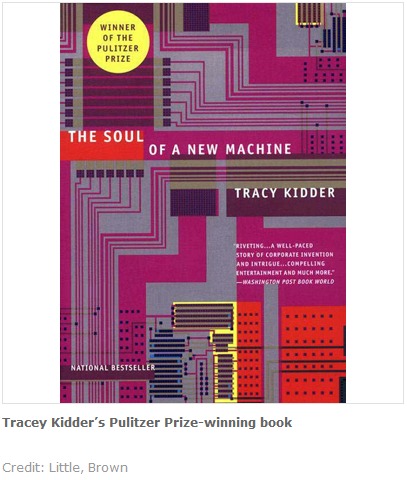博文
半导体里程_博物馆_1978 用户可编程逻辑设备出现
|||

发明单片存储器的约翰和HT蔡氏开发了易于使用的可编程阵列逻辑( PAL)和快速原型的定义逻辑功能的设备和工具
创意逻辑设计师意识到,小、快速的PROM (1971里程碑) ,也可以配置进行简单的逻辑功能。霍尼韦尔要求的基础上,于1975年,罗恩·克莱为适合更复杂的逻辑需求适应Signetics公司PROM电路技术设计了 82S100可编程逻辑阵列(PLA)。一个所需的功能,表示为布尔逻辑方程,是输入保险丝编程单元,即刻杂设计师的桌面上生成一个定制的IC 。
约翰和H.T.蔡氏与安迪陈在1978年推出的一个更精简的架构,他们称为可编程阵列逻辑(PAL) ,其交易逻辑灵活,有更快的速度和更低的成本。 PALASM ( PAL汇编)软件设计工具也开发出了易于使用的设备。License与AMD、国家、TI一致将20针双极型器件( 16L8 , 16R8等)确立为行业标准的产品。他们在特雷西基德的一台新机器的灵魂(1981年) ,成为一个时代的技术畅销特色。AMD( 22V10 )的一个更加灵活的架构 ,来自赛普拉斯和莱迪思的低功率CMOS技术,和可重复使用的CMOS为基础的EPROM器件支持PC兼容Altera设计原理图输入工具(1983年)扩大其应用范围。



图四 特蕾西基德的普利策奖获奖书
校对:
版权 copyright by www.computerhistory.org
1978 - PAL User-Programmable Logic Devices Introduced
John Birkner and H. T. Chua of Monolithic Memories develop easy-to-use programmable array logic (PAL) devices and tools for fast prototyping custom logic functions.
Creative logic designers realized that small, fast PROMs (1971 Milestone) could also be configured to perform simple logic functions. Based on a request from Honeywell, in 1975 Ron Cline adapted Signetics PROM circuit technology to design the 82S100 Programmable Logic Array (PLA) to serve more complex logic needs. A desired function, expressed as set of Boolean logic equations, was entered into a fuse programming unit that instantly generated a custom IC on the designer's desktop.
John Birkner and H.T. Chua of Monolithic Memories worked with Andy Chan to introduce a more streamlined architecture they called Programmable Array Logic (PAL) in 1978 that traded logic flexibility for faster speed and lower cost. The PALASM (PAL Assembler) software design tool also made the devices easy to use. License agreements with AMD, National, and TI established the 20-pin bipolar devices (16L8, 16R8, etc) as industry standard products. They are featured in Tracey Kidder’s The Soul of a New Machine (1981), a technology bestseller of the era. A more versatile architecture from AMD (22V10), CMOS technology for lower power from Cypress and Lattice, and reusable CMOS EPROM-based devices supported by PC-compatible schematic-entry design tools from Altera (1983) expanded their range of applications.
Xilinx (1984), Actel (1985), and QuickLogic (1988) introduced Field Programmable Gate Array (FPGA) architectures to serve higher gate-count applications. System designers selected one of these user-configurable solutions, collectively known as PLDs (Programmable Logic Devices), over ASIC approaches (1967 Milestone) as the preferred approach to custom digital logic for all but the lowest cost or highest performance application.
https://m.sciencenet.cn/blog-652849-544137.html
上一篇:半导体里程_博物馆_1979 单芯片数字信号处理器出现
下一篇:半导体里程_博物馆_1974 量化集成电路工艺设计规则的缩放